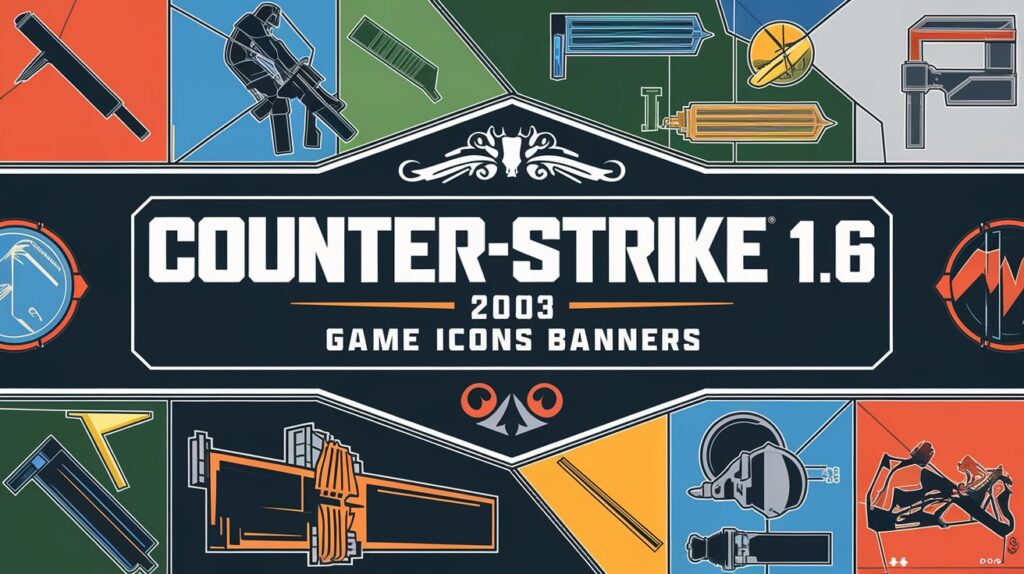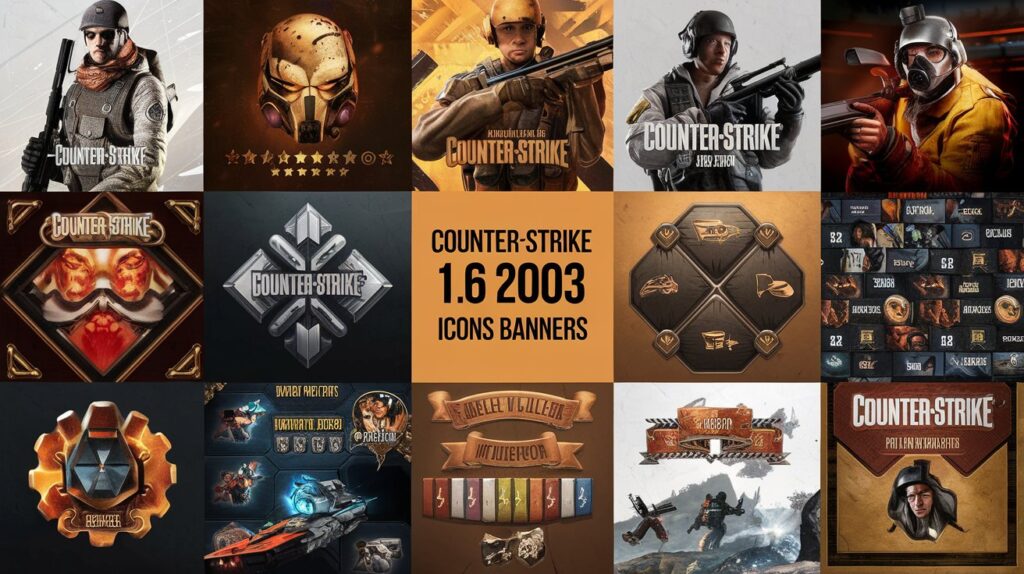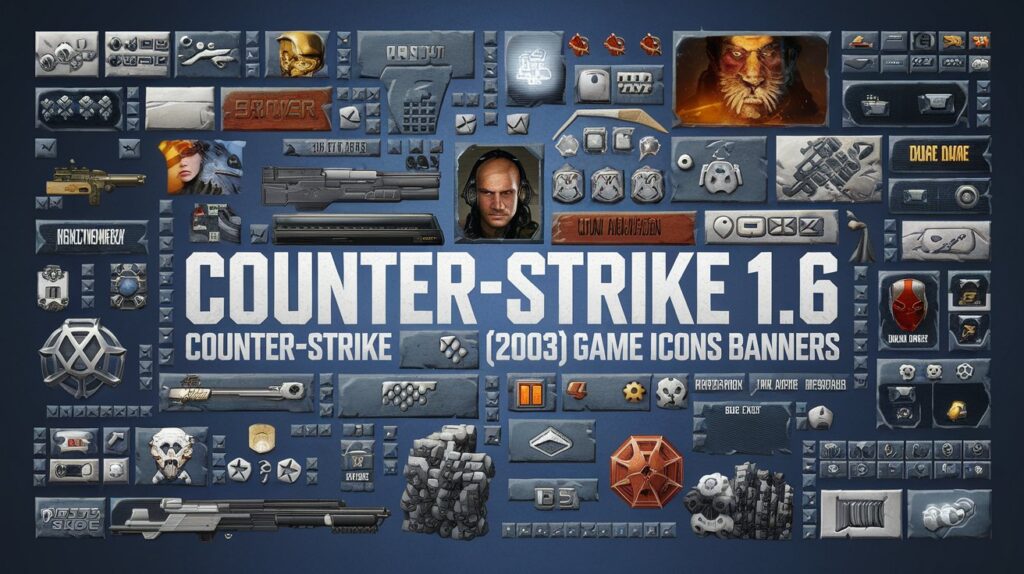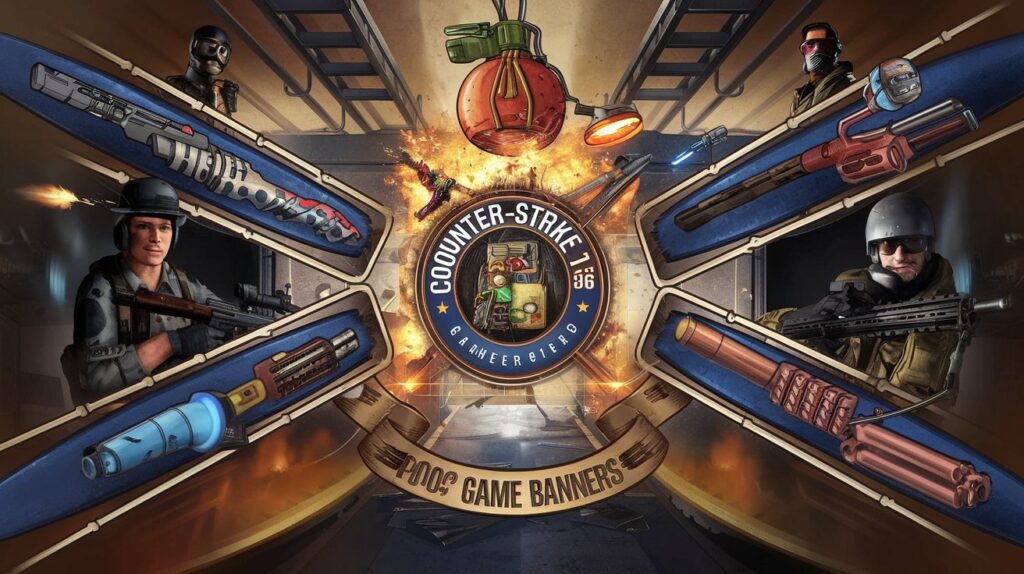
Counter-Strike 1.6 (2003) is not just a game; it’s a phenomenon that changed the landscape of first-person shooters (FPS) forever. The game’s lasting impact can be attributed to its balanced gameplay and competitive nature and the unique, memorable visuals that became synonymous with its identity. Counter-Strike 1.6 (2003) game icons banners played a pivotal role, making them integral elements of the game’s enduring legacy.
The Significance of Game Icons
Game icons in Counter-Strike 1.6 (2003) game icons banners are more than just decorative symbols. They serve as vital communication tools, conveying critical information to players in the heat of battle. Every icon is designed with clarity and simplicity, ensuring that even under the pressure of intense gameplay, players can quickly assess their surroundings and make informed decisions.
Icons for weapons like the AK-47, M4A1, and the infamous AWP are instantly recognizable to fans. These weapons’ detailed yet clear designs became ingrained in the player’s mind, making it easy to identify what they or their opponents are carrying. These visuals directly influenced player strategy, as different icons represented varying levels of threat based on weapon choice.
Besides weapons, the icons for items like health kits, armor, and grenades also became part of this visual language. Each icon had a purpose, telling the player if they had sufficient resources to continue battling or whether they needed to retreat and regroup. The defuse kit icon, for instance, became iconic in its own right, as it signified the crucial item that could turn the tide of a round for Counter-Terrorists.
Equally important were the objective-based icons, such as the bomb, hostages, and the VIP. These visual cues played a crucial role in team coordination. The bomb icon, for example, is immediately associated with the tension of a ticking timer, adding a layer of urgency to any match.

How Banners Shape Team Identity
Beyond gameplay, Counter-Strike 1.6 (2003) game icons banners contributed to the competitive spirit of the game. Banners acted as symbols of pride for teams, allowing players to represent their collective identity through customizable designs. They were often displayed during the pre-match warm-up and, more importantly, when a team achieved victory.
Banners became synonymous with recognition in the gaming community. Teams often created custom banners featuring their logos, colors, and slogans, instantly resonating with fans and spectators alike. These designs were not just about aesthetics; they communicated the team’s ethos, often highlighting its core values, such as resilience, strategy, and unity.
The most popular banner designs incorporated elements such as:
- Team Logos: Some of the earliest esports teams developed instantly recognizable logos that appeared on their in-game banners. These logos became brands in their own right, rallying a fanbase and elevating the competitive spirit in matches.
- Slogans: Teams often included motivational slogans or quotes on their banners to express their goals and team dynamics. These phrases helped shape the team’s narrative during a tournament as reminders of their purpose.
- Tribal Patterns: Tribal designs often appeared on banners, contributing to an intimidating and aggressive appearance. These bold patterns conveyed strength and determination, often used to strike fear into the hearts of opposing teams.
- National Flags: For teams playing in international tournaments, banners often featured national flags as a source of pride. Representing one’s country added a layer of significance to the competition, blending personal identity with professional gaming.

Enduring Influence of CS 1.6’s Visuals
Despite being released in 2003, the visual elements from Counter-Strike 1.6 (2003) game icons banners continue to influence modern gaming. For many, these icons and banners symbolize the golden age of competitive FPS gaming. Their minimalist yet functional design has set a standard for game developers, demonstrating how visual elements can shape player experience without overwhelming them.
As modern games evolve with more complex and detailed visuals, the straightforward approach seen in Counter-Strike 1.6 (2003) game icons banners stands out for its effectiveness. Modern competitive games like Counter-Strike: Global Offensive (CS
) still take inspiration from the simplistic, clear designs of CS 1.6, proving that less can indeed be more.
Why Are These Icons and Banners So Memorable?
The success of Counter-Strike 1.6 (2003) game icons banners can be attributed to the psychology behind good design. Icons in CS 1.6 are clean, identifiable, and instantly recognizable. They follow a simple rule: convey as much information as possible without distraction. The absence of overly detailed textures means the icons stay relevant even in fast-paced, stressful situations.
Similarly, banners allowed for creativity while staying true to the game’s competitive nature. The game fostered a sense of ownership and pride among players by enabling teams to personalize their banners. This led to the development of a strong community identity where teams were remembered for their performance and iconic banners that stood out tournament after tournament.

Also Read: Your Topics | Multiple Stories
The Legacy Lives On
The legacy of Counter-Strike 1.6 (2003) game icon banners lives on through nostalgic players and new generations discovering the game for the first time. Competitive scenes may have evolved, but the simplicity and effectiveness of these icons and banners remain unmatched.
Today, esports teams continue to innovate with their banners, carrying the traditions established by CS 1.6 into the future. Meanwhile, the game’s icons are still celebrated in gaming forums, memes, and fan art. They have become a cultural reference for FPS enthusiasts who appreciate how the smallest visual detail can significantly impact a game.
Conclusion
The visual elements of Counter-Strike 1.6 (2003) game icons banners played a crucial role in defining the game’s identity and legacy. From the clear, functional game icons to the personalized, competitive banners, these elements elevated the gaming experience for players. Even two decades later, these visuals inspire both the gaming community and game developers, serving as a timeless example of how thoughtful design can enhance gameplay without sacrificing simplicity.
Would the same competitive gaming culture exist today without these iconic designs? The answer likely leans toward no. Counter-Strike 1.6’s visuals, combined with its legendary gameplay, set the standard for what it means to design with both form and function in mind.

[…] Also Read: Counter-Strike 1.6 (2003) Game Icons Banners […]